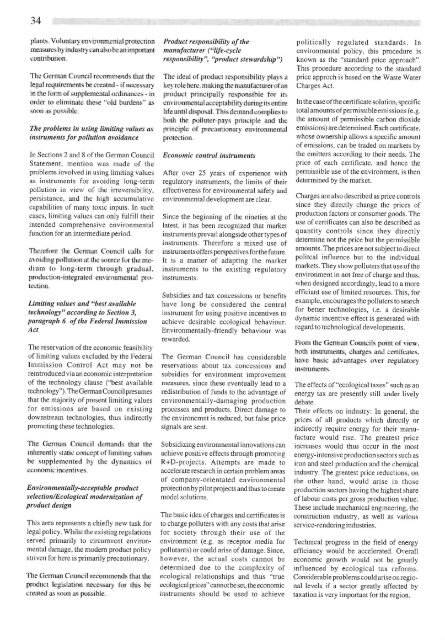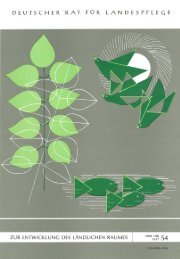Ökologische Umstellungen in der industriellen Produktion
Ökologische Umstellungen in der industriellen Produktion
Ökologische Umstellungen in der industriellen Produktion
Erfolgreiche ePaper selbst erstellen
Machen Sie aus Ihren PDF Publikationen ein blätterbares Flipbook mit unserer einzigartigen Google optimierten e-Paper Software.
34<br />
pl,mt'> Vnluntar~ en\1ronment:d protccuon<br />
mensure,.., b) mdut !><br />
..:nvm<strong>in</strong>mentul a1..c•·ptabihl) dunng 1t... c11t1re<br />
hfe unt1 I d1spo~a1 Tim demand comphes to<br />
both the polluter-pays pri1K1pk and thc<br />
punc1ple oi p1c1:.tutJonar; en\llvnmental<br />
p101ec11on<br />
Economic control <strong>in</strong>struments<br />
After over 25 years of experience with<br />
regulatory <strong>in</strong>struments, the limits of their<br />
cffcctiveness for environmental safety and<br />
em·ironmental development ai·e clear.<br />
S<strong>in</strong>ce the beg<strong>in</strong>n<strong>in</strong>g of the n<strong>in</strong>eties at the<br />
latest, it has been recognized that market<br />
<strong>in</strong>struments prevail alongside othertypes of<br />
<strong>in</strong>struments. Therefore a mixed use of<br />
<strong>in</strong>struments offers perspectives forthe future.<br />
lt is a matter of adapt<strong>in</strong>g the market<br />
<strong>in</strong>struments to the exist<strong>in</strong>g regulatory<br />
<strong>in</strong>struments.<br />
Subsidies and tax concessions or benefits<br />
have long be consi<strong>der</strong>ed the central<br />
<strong>in</strong>strument for us<strong>in</strong>g positive <strong>in</strong>centives to<br />
achieve desirablc ecological behaviour.<br />
Environmentally-friendly behaviour was<br />
rewarded.<br />
The German Council has consi<strong>der</strong>able<br />
reservations about tax concessions and<br />
subsidies for environment improvement<br />
measures, s<strong>in</strong>ce these eventually lead to a<br />
redistribution of funds to the advantage of<br />
environmentally-damag<strong>in</strong>g production<br />
processes and products. Direct damage to<br />
the environemnt is reduced, but false price<br />
signals are sent.<br />
Subsidiz<strong>in</strong>g environmental <strong>in</strong>novations can<br />
achieve positive effects through promot<strong>in</strong>g<br />
R+D-projects. Attempts are made to<br />
accelerate research <strong>in</strong> certa<strong>in</strong> problem areas<br />
of company-orientated environmental<br />
protection by pi Jot projects and thus to create<br />
model solutions.<br />
The basic idea of charges and certificates is<br />
to charge polluters with any costs that arise<br />
for society through their use o f the<br />
environment (e.g. as receptor media for<br />
pollutants) or could arise of damage. S<strong>in</strong>ce,<br />
however, the actual costs cannot be<br />
deterrn<strong>in</strong>ed due to the complexity of<br />
ecological relationships and thus "true<br />
ecological prices" cannot beset, theeconomic<br />
<strong>in</strong>strurnents should be used to achieve<br />
politically regulated Standards. In<br />
e nvironmental policy, this procedure is<br />
known as the "standard price approach".<br />
This procedure accord<strong>in</strong>g to the standard<br />
price approch is based on the Waste Water<br />
Charges Act.<br />
In the case ofthecertificatesolution, specific<br />
total amounts of perrnissibleemissions (e.g.<br />
the amounl of permissible carbon dioxide<br />
emissions) aredeterm<strong>in</strong>ed. Each certificate,<br />
whose ownership allows a specific amount<br />
of ernissions, can be traded on markets by<br />
the cmitters accord<strong>in</strong>g to their needs. The<br />
price of each certificate, and hence the<br />
permissible use of the environment, is then<br />
determ<strong>in</strong>ed by the market.<br />
Ch arges are also described as price controls<br />
s<strong>in</strong>ce they directly change the prices of<br />
production factors or consumer goods. The<br />
use of cenificates can also be described as<br />
quantity controls s<strong>in</strong>ce they directly<br />
deterrn<strong>in</strong>e not the price but the perrnissible<br />
arnounts. The prices are not subject to direct<br />
politcal <strong>in</strong>fluence but to the <strong>in</strong>dividual<br />
rnarkets. They show polluters that use of the<br />
environment <strong>in</strong> not free of charge and thus,<br />
when designed accord<strong>in</strong>gly, lead to a rnore<br />
efficiant use of limited resources. This, for<br />
example, encourages the polluters to search<br />
for better technologies, i.e. a desirable<br />
dynamic <strong>in</strong>centive effect is generated with<br />
regard to technological developments.<br />
.From thc Gennan C'11unc1h pumt ot \JC\\.<br />
hoth m~u1.1mt:nt:, , duu·ge~ .111d certtlcalö.<br />
h:n e ha;,i..: ..t
















